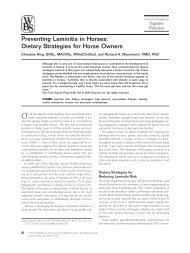Nutritional Secondary Hyperparathyroidism in the Horse
Nutritional Secondary Hyperparathyroidism in the Horse
Nutritional Secondary Hyperparathyroidism in the Horse
You also want an ePaper? Increase the reach of your titles
YUMPU automatically turns print PDFs into web optimized ePapers that Google loves.
(:l<strong>in</strong>ico-pathologic Determ<strong>in</strong>ations 51<br />
a) A diet with a calcium to phosphorus ratio of 1 : 3.68 immedia-<br />
tely caused hyperphosphatemia.<br />
13) Serum calcium first <strong>in</strong>creased slightly and <strong>the</strong>n decreased (NSH<br />
1 and NSH 3) or decreased immediately (NSH 2). Hyperphosphatemia<br />
and hypocalcemia progressed for about 10 weelis.<br />
c) Cl<strong>in</strong>icopathologic evidences of hyperparathyroidism were<br />
manifest at <strong>the</strong> 11th week (NSH 1 and 3) or at <strong>the</strong> 13th week (NSH 2).<br />
At week 11 <strong>the</strong> serum P dropped <strong>in</strong> NSH 1 and 3. In NSI-I 2 this did<br />
not occur, but <strong>the</strong> progress<strong>in</strong>g hyperphosphatemia was partly arrested.<br />
As <strong>the</strong> serum phosphorus started to decrease, a rise <strong>in</strong> serum calcium<br />
occurred.<br />
Dur<strong>in</strong>g <strong>the</strong> next phase, cover<strong>in</strong>g <strong>the</strong> period from week 12 to week<br />
23, serum phosphorus <strong>in</strong>creased until it reached maximum and <strong>the</strong>n<br />
decreased rapidly. Dur<strong>in</strong>g <strong>the</strong> same period serum calcium rose all <strong>the</strong><br />
time, although compensation was not complete.<br />
At <strong>the</strong> end of this period <strong>the</strong> dietary calcium to phosphorus ratio<br />
was decreased from 1 : 3.68 to 1 : 6.19. Serum phosphorus <strong>the</strong>n<br />
<strong>in</strong>creased from week 23 through week 30, whereas serum calcium<br />
decreased dur<strong>in</strong>g <strong>the</strong> same period of time.<br />
At week 30 <strong>the</strong> serum calcium reached its second m<strong>in</strong>imum. The<br />
hyperparathyroidism now caused decreas<strong>in</strong>g serum phosphorus and<br />
<strong>in</strong>creas<strong>in</strong>g serum calcium levels <strong>in</strong> all NSH horses.<br />
d) The product of total serum calcium and serum phosphorus<br />
described a triphasic curve over <strong>the</strong> experiment. The curves of <strong>the</strong>se<br />
products were similar to those of serum phosphorus. The sequence of<br />
events was:<br />
i) Increase; hyperphosphatemia greater <strong>in</strong> degree than hypo-<br />
calcemia.<br />
ii) Decrease ; hypocalcemia of relatively greater degree than hyper-<br />
phosphatemia, which showed a temporary and partial compensation.<br />
iii) Increase; both phosphorus and calcium <strong>in</strong>creas<strong>in</strong>g; maximum<br />
product reached after 16, 20, and 20 weelis <strong>in</strong> NSH 1, 2, and 3,<br />
respectively.<br />
iv) Decrease ; hyperphosphatemia compensated for to a greater<br />
degree than hypocalcemia. In <strong>the</strong> middle of this phase <strong>the</strong> dietary ratio<br />
of calcium and phosphorus was decreased, result<strong>in</strong>g <strong>in</strong> <strong>in</strong>creas<strong>in</strong>g serum<br />
phosphorus levels but <strong>in</strong> still lower serum calcium levels; net result,<br />
thus, decreased product.<br />
Downloaded from<br />
vet.sagepub.com by guest on April 14, 2010



